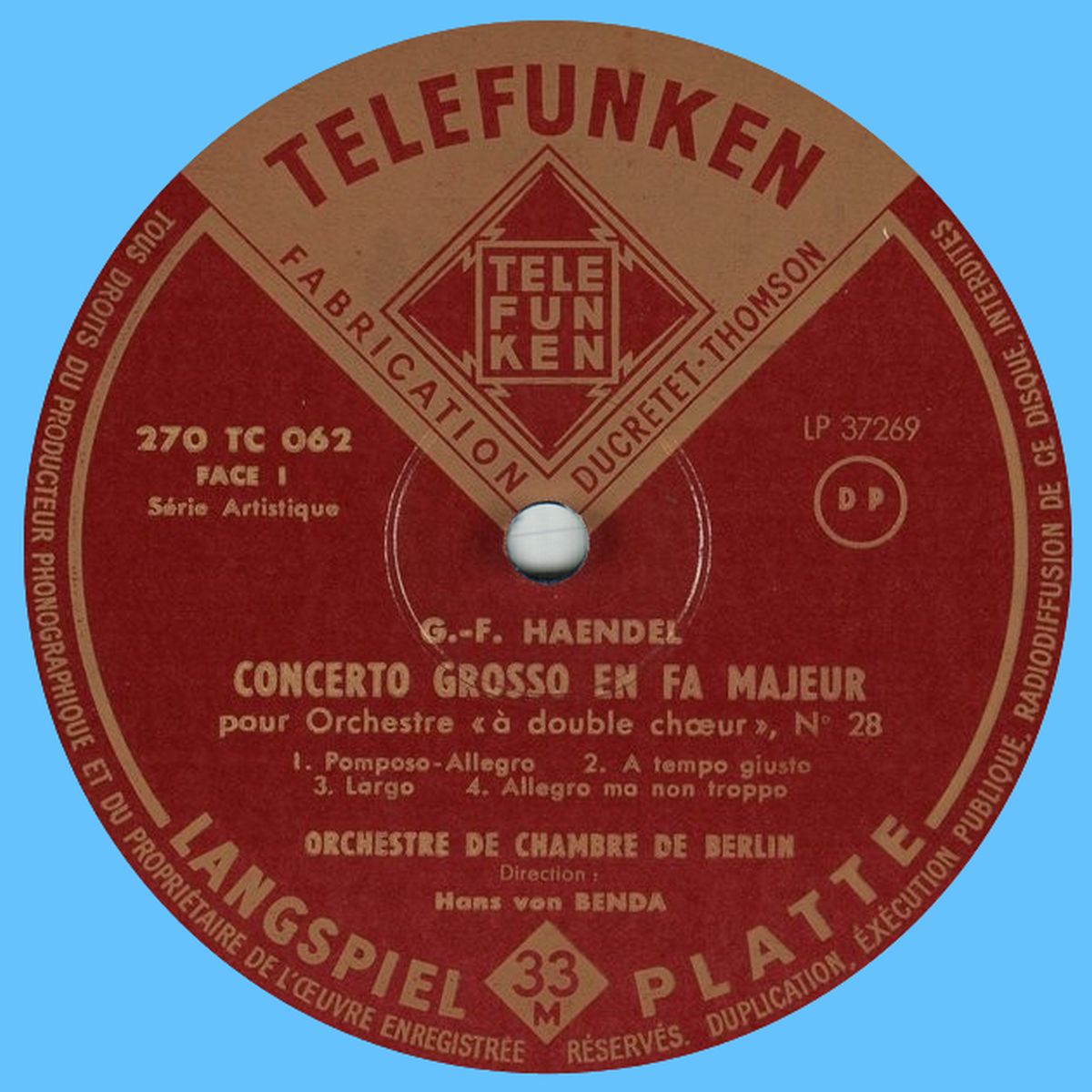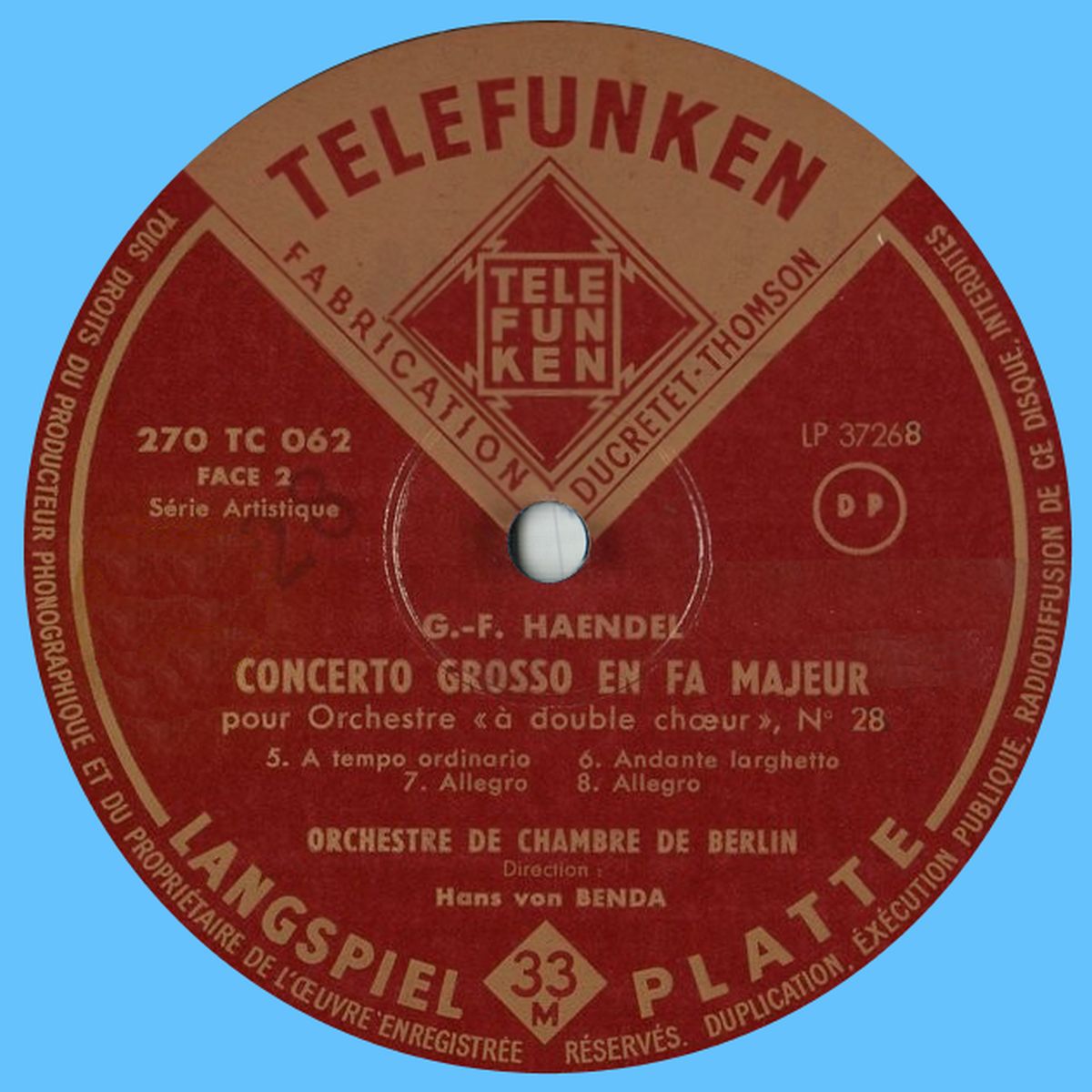Illustrant l'en-tête: extrait d'une photo de Hans von Benda datant du début des années 1940.
À droite: Hans von Benda en 1949, portrait extrait d'un programme de concert, Centre de Documentació de l'Orfeó Català, document PMC 1949-05-01 (05) matí lib. En-dessous Hans von Benda en 1943, extrait d'une photo avec Dinu Lipatti, Athenäum de Bukarest, Landesarchiv Baden-Württemberg, Abt. Staatsarchiv Freiburg, W 134 Nr. 033506b, Sammlung Willy Pragher I: Rumänienbilder >> Bühne [Filmnegative, Ordner 286], Rechteinhaber: Landesarchiv Baden-Württemberg, Digitalisat im Angebot des Archivs.
Georg Friedrich HÄNDEL
Concerto a due cori en fa majeur (No 3), HWV 334
5e, 6e et 2e mouvements
Kammerorchester Berlin, Hans von BENDA
Ducretet Thomson / Telefunken 270 TC 062
09-14.06.1954, Lichterfelder Festsäle, Berlin
Pour quelques détails sur l'oeuvre et - surtout - sur le disque Ducretet Thomson / Telefunken 270 TC 062 et les autres éditions, voir la page du concerto a due cori No 2 HWV 333, publié au recto et au début du verso de ce disque.
Ce disque m'a d'abord laissé perplexe, mais la solution est en fait simple...
Hans von BENDA enregistra ce «Concerto grosso en fa majeur pour Orchestre "à double choeur", No 28» avec le Kammerorchester Berlin. L'enregistrement fut publié sur le disque 25cm Ducretet Thomson / Telefunken 270 TC 062 (photos des étiquettes ci-contre, ainsi qu'au bas de cette page).
En fait - dans les diverses éditions, voir par exemple la restauration du disque Telefunken TW 30153 publiée sur cette page du site satyrlp.blogspot, il s'agit des deux concertos HWV 333 et 334 (seulement une partie pour ce dernier), rassemblés en une seule oeuvre intitulée ici «Doppelchöriges Orchesterkonzert no.28» (ce No 28 provient d'une édition Breitkopf portant ce numéro).
Au verso de la pochette de ce disque TW 30153 est mentionné:
"[...]Das Werk war ursprünglich in sechs Sätzen überliefert. Es fand sich aber viel später noch das Manuskript von weiteren drei Sätzen, die unzweifelhaft dazugehören. In dieser auf acht (*) Sätze vervollständigten Fassung wird das Konzert hier gespielt. Die Besetzung mit 8 Oboen, 4 Fagotten und 6 Hörnern nebst dem Streichorchester entspricht dem Brauch der damaligen Zeit und dem besonderen Zweck seiner Aufführung im Freien. [...]"
[*] «acht» - huit - parce que les deux mouvements ouvrant l'oeuvre - «Pomposo» et «Allegro» - sont sur ces divers disques mentionnés comme appartenant à un seul mouvement «Pomposo - Allegro», bien que la courte pause entre les deux soit claire et nette. J'en ignore la raison: si une personne visitant cette page devait en savoir plus, toutes informations m'intéressent -> Vos remarques!
La parution du disque Ducretet Thomson / Telefunken 270 TC 062 est mentionnée en page 207 du 3e supplément du WERM 1953-1955 (avec deux autres éditions de Telefunken: DT.LGM 65022 et T.NLB 6079). L'enregistrement est donc antérieur à 1955: d'après la discographie de Michael Gray il s'agit d'une prise de son des 9 au 14 juin 1954, Lichterfelder Festsäle de Berlin.
Le verso du disque commence avec le dernier mouvement du HWV 333 - «A tempo ordinario»: suivent ensuite ces 5e, 6e et 2e mouvements du HWV 334 actuel, qui à cette époque n'était toutefois pas encore connu comme tel.
La première publication faisant expressément mention du Concerto a due cori No. 29 en six mouvements - le HWV 334 tel que que nous le connaissons aujourd'hui - est celle de August Wenzinger, un disque Deutsche Grammophon enregistré en mars 1962 avec la Schola Cantorum Basiliensis, Rudolf-Oetker-Halle, Bielefeld.
Sa parution est présentée dans la revue «The Gramophone» de décembre 1962, en pages 290-291. L'article mentionne...
"[...](b) Concerti a due cori in F major, Nos. 2 and 3 (Orchestral concertos Nos. 28 and 29) [...] These pieces, only fairly recently sorted out from various scattered manuscripts, are ideally suited to stereo, consisting largely of otherwise familiar music newly laid out for two opposing wind groups (each of two oboes, two horns, and two bassoons) with supporting string orchestra and continuo. [...]".
Au verso de la pochette de la première édition du disque d'August Wenziger - DG Archive Production 198646 SAPM - sont données les précisions suivantes:
"[...] The two orchestral concertos (Concerti a due cori) in F major, Nos. 28 and 29, are also occasional compositions by Handel, probably dating from the period between 1746 and 1751. They include Handel's own transcriptions of popular choruses from «The Messiah», the «Birthday Ode for Queen Anne», the two versions of «Esther» and the «Occasional Oratorio». The scoring is for two wind ensembles, each consisting of 2 horns, 2 oboes and 2 bassoons, together with a string orchestra and continuo. These double concertos were occasional works, intended primarily for open-air performances, and they were played before large audiences during popular festivities. [...]
A clear picture of the origins of the two concertos, their history and the number and sequence of their movements, has been obtained only recently, although as long ago as 1894 Chrysander referred to the existence of these two concertos in the explanations to the supplementary volume to Vol. 47 of the complete edition of Handel's works. Chrysander was originally of the opinion that the nine movement concerto published in Vol. 47, transcribed from a manuscript in Buckingham Palace, with its fragmentary 10th movement, formed a single work which had survived in an incomplete form. On the other hand he stated in the explanations already mentioned that the double concerto (No. 28) «was not intended to contain all the music published in Vol. 47, pages 159 to 231, but concludes on page 202, as Handel indicated by the word 'Fine'». According to his conclusions, therefore, the 9 (or including the incomplete one 10) movements published in Vol. 47 are not to be regarded as making up a single work, in fact, forming a complete concerto with 6 movements, followed by a further 3 (4) separate pieces. These spare pieces belong, as Chrysander explained, to another double concerto (No. 29), whose remaining movements were discovered in the autograph in the Fitzwilliam Museum, Cambridge. This discovery clarified the question of the succession of movements in the second work, so that the present recording of the two concerti a due cori presents them for the first time in their authentic forms.
This music, broad in conception, making use as it does of echo effects and easily assimilated wind instrument melodies, is of great simplicity and impressiveness. The monumental choral style of the oratorios has here been skilfully transferred to concerto form, so that the new versions are by no means inferior to the originals in tonal richness and splendour. The best-known example is the 3rd movement of Concerto No. 28, a transcription of the chorus «Lift up your heads» from «The Messiah», in which the antiphonal technique of the original version has been adapted with especial felicity to the characteristics of a double orchestra. The other arrangements all diverge to a greater or lesser degree from the original forms, so that they are perfectly suited to the purely instrumental scoring.
«Handel possessed an outstandingly fine feeling for form. No German composer exceeded the beauty of his melodic lines, only Mozart and Hasse equalling him in this respect. Handel's passion for perfection was responsible for the fact that despite his overflowing inventive power he turned again and again to the same ideas those which were best known and which he held in highest favour each time introducing a scarcely noticeable alteration, a pencil mark which made the music even more perfect.»(Romain Rolland).[...]" cité du texte de Günter Schneider publié au verso de la pochette du disque DG Archive Production 198646 SAPM.
Voici donc...
Georg Friedrich Händel, Concerto a due cori en fa majeur (No 3), 5e, 6e et 2e mouvements, HWV 334, Kammerorchester Berlin, Hans von Benda, 9 au 14 juin 1954, Lichterfelder Festsäle, Berlin
01. V Andante larghetto 03:52 (-> 03:52)
02. VI Allegro 01:48 (-> 05:40)
03. II Allegro - Allegro ma non troppo 02:50 (-> 08:30)
Les fichiers sont numérotés comme publiés sur ce disque, avec en plus les numéros des mouvements du HWV 334 en chiffres romains
Provenance: Ducretet Thomson / Telefunken 270 TC 062
que vous pouvez obtenir en...
3 fichiers FLAC, 2 fichiers CUE (*) et 1 fichier PDF dans 1 fichier ZIP
(*) 1 fichier CUE pour les fichiers décomprimés en WAV et 1 fichier CUE pour les fichiers comprimés FLAC, si votre logiciel peut utiliser directement les fichiers FLAC.
Disque 25cm Ducretet Thomson / Telefunken 270 TC 062, Étiquette face recto
Disque 25cm Ducretet Thomson / Telefunken 270 TC 062, Étiquette face verso




